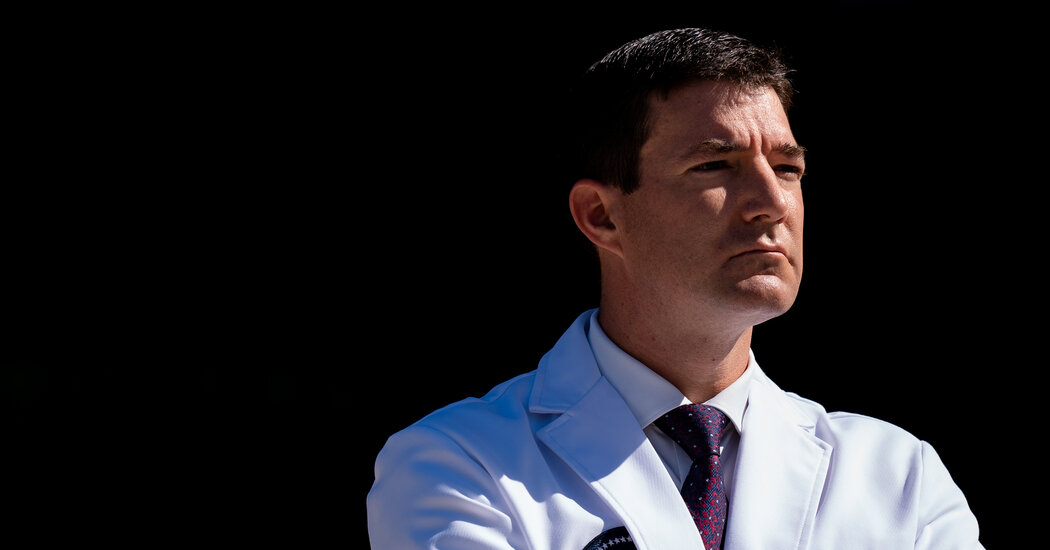The White House physician, Dr. Sean P. Conley, predicted in a memo released Thursday that President Trump could safely “return to public engagements” on Saturday, based on the date on which he tested positive for the coronavirus and his response to treatments.
The document, which offered a brief overview of Mr. Trump’s vital signs, said that the president had completed his “course of therapy for Covid-19” and had “remained stable and devoid of any indications to suggest progression of illness.”
But news of Mr. Trump’s potentially imminent return to public appearances or the campaign trail was met with skepticism and alarm from medical experts, who suggested it was premature and questioned whether the end of his isolation met guidelines from the Centers for Disease Control and Prevention.
In a video released on Wednesday, the president declared that his tussle with the coronavirus was a “blessing from God,” and he portrayed as a “cure” the experimental antibody treatment he had received from the drug company Regeneron.
Following the release of Dr. Conley’s memo, Mr. Trump’s re-election campaign released a statement calling for the second presidential debate to take place as originally scheduled on Thursday. The document said there was “no medical reason why the Commission on Presidential Debates should shift the debate to a virtual setting, postpone it or otherwise alter it in any way.”
But experts said that resuming public duties might worsen the president’s condition, which could still rapidly deteriorate in the next several days. Covid-19, an unpredictable disease, can suddenly and unexpectedly deteriorate during a patient’s second week of illness.
Based on the information provided, “No, I would not clear him to start public engagements on Saturday,” said Dr. Phyllis Tien, an infectious-disease physician at the University of California, San Francisco, where she conducts and advises on Covid-19 clinical trials.
The memo listed the president’s heart rate (69 beats per minute), blood pressure (127/81), respiratory rate (15 to 17 breaths per minute) and blood oxygen levels (96 to 98 percent with no supplemental oxygen). The memo did not indicate Mr. Trump’s temperature.
All of those vital signs are within the normal range, said Dr. Krutika Kuppalli, an infectious-disease physician based in South Carolina. But the numbers represent only a snapshot in time, she added. More telling would be statistics charting the president’s vital signs while he was moving around, Dr. Kuppalli said. “When he walks, does his oxygen fall?” she said. “Does his heart rate go up? Does he have to work harder? That would be important to know.”
If the president recently came off dexamethasone, a steroid normally administered only to severely sick Covid-19 patients, his well-being could take a dip in the next couple of days, Dr. Kuppalli said.
Dr. Conley’s statements on Monday suggested that Mr. Trump might be at risk through Saturday and Sunday. “We’re looking to this weekend,” he said at a news conference. “If we can get through to Monday, with him remaining the same — or improving, better yet — then we will all take that final deep sigh of relief.”
An inappropriately expedited return to the public for Mr. Trump could also imperil others through close contact.
According to C.D.C. guidelines, people with mild to moderate cases of Covid-19 most likely “remain infectious no longer than 10 days after symptom onset.” Dr. Conley’s statement cited Saturday as “day 10 since Thursday’s diagnosis.”
Dr. Tien said she was skeptical of such an assessment. The slew of treatments Mr. Trump received, she said, suggest that his disease was severe, which could extend the duration of his recommended isolation to 20 days after the onset of symptoms.
Mr. Trump might be able to end his isolation early if he tested negative for the virus, using a very accurate laboratory test, Dr. Tien said. But no such results were reported in Thursday’s memo, which mentioned only a “trajectory of advanced diagnostics.”
Such vague wording could be interpreted to mean a definitive test for infectiousness, which “to my knowledge, doesn’t exist,” said Dr. Taison Bell, a critical care physician at the University of Virginia. “I wish I could learn from Dr. Conley what they’re doing.”
Even if Mr. Trump met the criteria for a mild or moderate case of Covid-19, a Saturday release from isolation might not pass muster. While the president is known to have been diagnosed on Oct. 1, the point at which his symptoms began appearing remains murky. If they first manifested on Sept. 30, then Saturday could qualify as 10 days post-symptom onset. If they started on Oct. 1, Day 10 would be Sunday.
The C.D.C. stipulates that “for most persons with Covid-19 illness, isolation and precautions can generally be discontinued 10 days after symptom onset and resolution of fever for at least 24 hours, without the use of fever-reducing medications, and with improvement of other symptoms.”
“I don’t know how I would classify his disease,” Dr. Bell said. “Without knowing him as a patient, it’s hard to make that determination.” Still, he added, it would be wise to proceed with caution, given the risks.
“This is bigger than him,” Dr. Kuppalli said. “Everyone is going to have a different point of view. But I would still err on the safe side, and keep him isolated for 20 days.”
[ad_2]
Source link


